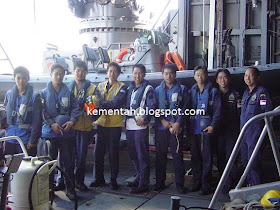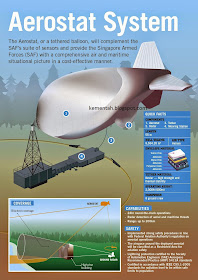Ten years ago today, I sent sail from the Republic of Singapore Navy's Tuas Naval Base aboard RSS Endurance with the Singapore Armed Forces (SAF) tsunami relief mission to the Indonesian island of Sumatra.
At the time, our destination was unknown as was the duration of the then-unnamed operation. In time to come, Singaporeans came to know about the assignment as Operation Flying Eagle (OFE).
Am sharing some OFE pictures here for the first time. What's remarkable about the pictures is the fact that they were taken at all. I had stepped aboard Endurance without a camera because the Ministry of Defence (MINDEF) said so and I had no intention of flouting their security protocols. I complied (with 20:20 hindsight, this was stupid) and was assured by MINDEF and my newsroom that a photographer would soon join me en route.
As things turned out, the assignments editor couldn't tell the difference between Aceh (the Indonesian province) and Banda Aceh (the capital city of the aforementioned province) and happily despatched a photographer to BA where we would link up.
Alas, Endurance steamed past BA en route to Meulaboh as the Indonesians had said her help was more sorely needed at that part of the Sumatra coastline.
And so, off I went embedded with the SAF for the largest humanitarian without any camera to capture life on the sidelines.
As luck would have it, several kind-hearted servicemen soon got wind of my predicament. A camera magically appeared on my bunk with instructions that I was not to tell the OFE management where it came from as the device was contraband. So that secret has stayed safe with me for the past 10 years.
Even so, opsec rules were strictly observed. Not a single picture was taken in the ship's Ops Room or Radio Room, or in the then hush-hush bunks located below the tank deck even after I was more or less allowed to roam Endurance without a press escort.
OFE was the fourth and last SAF operation I was assigned to cover as a journalist. The 26 days outfield also marked the longest stint with an SAF operation.
This small photo essay is a tribute to the TNI and SAF operation which helped stabilise Meulaboh during those dark days. I treasure my time with the OFE team, the opportunity to work with the TNI up close and remember those who did not live to see 2005's sunrise. Ten years on, we honour their memory.
Aboard RSS Endurance with the chock and chain crew. Am fourth from left in this picture. Republic of Singapore Navy (RSN) and Singapore Army personnel volunteered to assist loading and unloading RSAF helicopters as the tempo of air operations, which saw frequent arrivals from thirsty cargo-laden helos, made such work energy sapping. During one of my first embeds with the Navy, an RSN officer taught me that the greatest threat aboard ship is fire. He narrated what synthetic fibres would do to a wound during a flash over and the precautions one should take. Since then, I have resolved that I would not be the weak link in the host ship during an operation and my shipboard gear includes the whole anti-flash ensemble comprising hood and elbow-length gloves, flame-resistant coveralls, safety boots and other stuff.
En route to Meulaboh, the crew aboard Endurance moved cargo and vehicles to clear a helo landing spot. This allowed the tank landing ship to serve as a lily pad for thirsty Super Pumas flying in from Medan. At this point in time, landing spots had yet to be cleared on the Indonesian mainland. During this phase of the operation, the tank landing ships were referred to as Helicopter Landing Ships. It was a baffling acronym for purists who consider such vessels landing platform docks (LPDs).
Maids of all work, RSN fast landing craft shuttled to and fro between shore and mothership from dawn to dusk. Some operations often stretched into the night. The Fast Craft Utility and smaller Fast Craft Equipment Personnel were vital for the logistics over the shore effort as the gradient of the beach at Meulaboh made direct beaching impractical. The TNI's Frosch-class LSTs, designed for landing in the Baltic, had to rely on RSN FCUs and FCEPs to land their cargo and personnel. Cooperation and coordination between TNI and SAF forces in Meulaboh was exemplary.
A Combat Engineer Tractor from the Singapore Army goes to work ashore. Such vehicles swam ashore from the LSTs. They were complemented by LARC V amphibious lighters. Sadly, I was unable to photograph a LARC V while in Meulaboh. :-(
A Republic of Singapore Air Force (RSAF) Chinook moments before touching down on an improvised landing zone built by the TNI and SAF. Aboard the heavy-lift helicopter, aircrew specialists were kept busy constantly scanned blind spots for obstructions, people or animals (like water buffaloes) who might get in the way. Unloading cargo-laden helos at such sites was labour intensive (see below) as this was conducted without the benefit of fork lifts. Soon after this picture was taken, your's truly joined the unloading team.
An RSAF Super Puma gingerly approaches an improvised landing pad made of earthworks compacted by shovel, boots and an overworked bulldozer from the Singapore Combat Engineers. The comparison with helicopter operations from Vietnam to Borneo springs readily to mind. Super Pumas were thirsty birds after making the overland flight from Medan across the mountain range to Meulahoh. Before such strips were carved out of the debris-strewn landscape, these helos conducted hot refuelling aboard the LSTs. This explains the urgency in clearing at least one landing spot for a Super Puma. To my eternal regret, I failed to cash in a standing offer from the HASG info ops team to see the devastation from the air. *sigh*
RSS Endurance is framed from the forward ramp of a fast landing craft. This was my home for 26 days from 31 December 2004 to 25 January 2005. In December 2003, I reported on the first SAF deployment to the Persian Gulf - codenamed Operation Blue Orchid - from the same ship. Familiarity with the ship's routine helped immensely during the adjustment process as one got used to the naval discipline aboard the 141-metre ship.
As with most ship Commanding Officers, the one for Endurance had his quirks. Her CO, Colonel Li Lit Siew, hated dust and made every effort to keep Endurance spick and span. Bunk inspections, led by her indefatigable Coxswain and an unsmiling Guards RSM, were a sight to behold. Yes, things flew in the bunks to the accompaniement of parade square drill instructions and notes scribbled on the confounded clipboard. The initial shakeup was unleashed on the houseguests aboard the LST as the Navy sought to bring the Singapore Army soldiers in line with RSN regimentation and discipline. They succeeded, eminently.
A TNI soldier stands guard at the beachhead with two Republic of Singapore Navy LSTs offshore. The rapport and friendship established between Indonesian and Singaporean military forces during OFE enabled the two forces to quickly bring a semblance of normalcy to the coastal town. Meulaboh had been hit by a double whammy of a powerful earthquake and devastating tsunami.
Senior officers on the starboard bridge wing of RSS Endurance pay homage to the Indonesian victims of the Boxing Day tragedy, and salute their counterparts from the TNI as the warship left Meulaboh for her voyage home. Pictured below are the wreaths jointly laid by the TNI and Singapore Armed Forces (SAF) in Meulaboh during a remembrance ceremony.
Throughout OFE, we drank from Cactus brand bottled water whose tagline was "Life Goes On". It was indeed a poignant reminder for all those in Meulaboh on how they should deal with the post-tsunami catastrophe.































